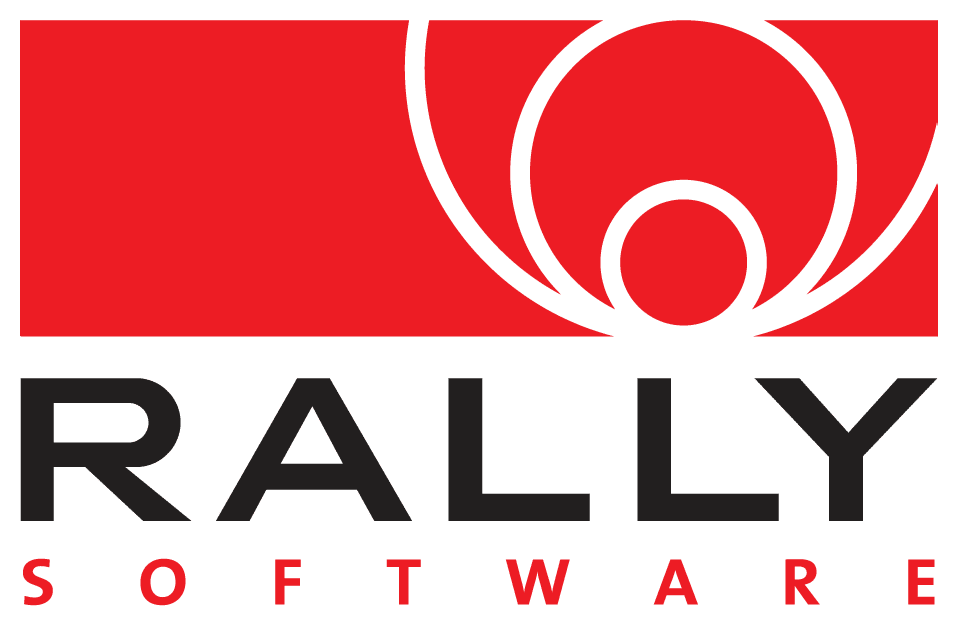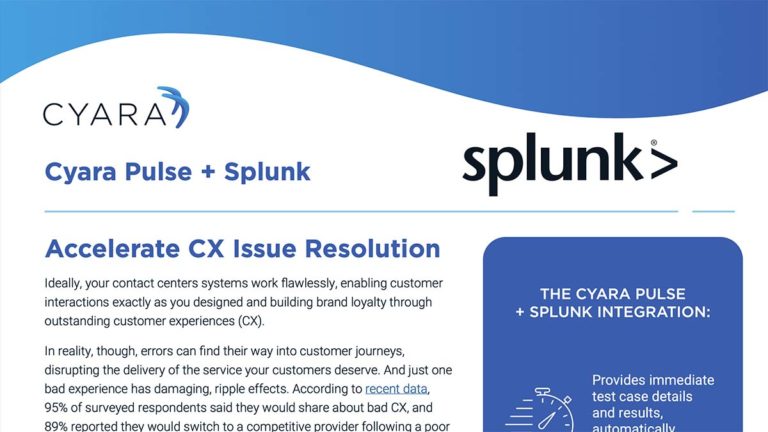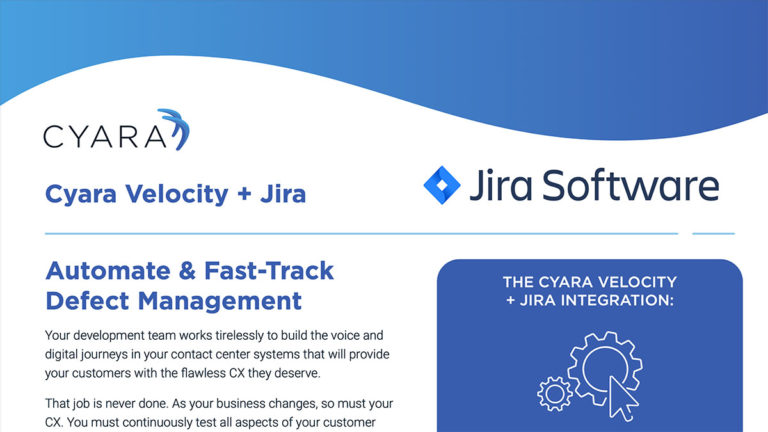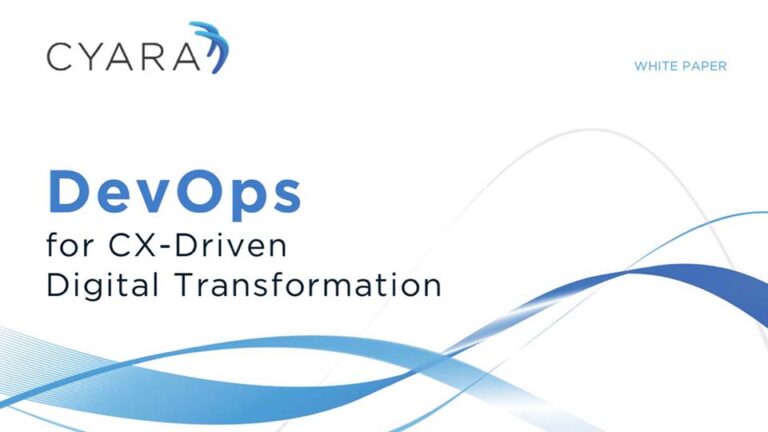Cyara Platform:
Technology Ecosystem Integrations
Easily Integrate the Cyara CX Assurance Platform with Your Agile and DevOps Technology Ecosystem

Cyara CX Assurance Platform Integrations
Agile Transformation
Defect
Tracking
Test
Management
Agile
Planning
DevOps Adoption
Continuous
Integration
Configuration
Management
Continuous
Deployment
CX Operations
IT
Monitoring
System
Ticketing
&
Support
Software development has become strategic for companies across all industries. Many companies are adopting the DevOps methodology for software development. As part of DevOps and Agile methodologies, companies are deploying software builds more frequently than ever before with 24% deploying weekly and 27% deploying daily1.
The challenge for companies is to ensure that customer experience (CX) technology is incorporated into these new software development processes. Companies that are undergoing a full DevOps transformation are borrowing tools and techniques (e.g., CI tools only, Agile SCRUMs) from the Agile/DevOps movement and linking to specialized CX technology. Integration to the DevOps toolchain are critical to accelerating release cycles and improving quality.
Integrate with the Agile and DevOps Ecosystem to Simplify Testing, and with IT Operations for Smarter Troubleshooting
Cyara Velocity enables your DevOps transformation by integrating with the best solutions for Agile transformation and DevOps adoption. Cyara Pulse provides CX incident management that integrates with IT monitoring and IT ticketing system applications.
Agile Transformation
Agile Transformation
Defect
Tracking
Test
Management
Agile
Planning
DevOps Adoption
Continuous
Integration
Configuration
Management
Continuous
Deployment
CX Operations
IT
Monitoring
System
Ticketing
&
Support
Integrate with the widely used tools for Agile software development for sprints, tasks, stories, bugs, and releases. Leverage Cyara assurance with test case management solutions for test cases, test plans, and test results.
Integration: Cyara Velocity Integration to Jira for Defect Tracking
Automate the filing of defects in Jira to facilitate continuous testing and rapid iteration.
- Lift defects from Jira to Velocity.
- Integrate Cyara test cases that test specific defects with Jira.
Learn more in the Cyara Velocity + Jira Integration datasheet.
Integration: Cyara Velocity Integration to Rally for Defect Tracking
Automate and fast-track CX defect management with auto-populated tickets that speed defect resolution and facilitate quality CX.
- Eliminate manual defect ticket detail data entry.
- Sync and link Cyara test cases with Rally, auto-populated with details that lead to faster defect resolution.
DevOps Adoption
Agile Transformation
Defect
Tracking
Test
Management
Agile
Planning
DevOps Adoption
Continuous
Integration
Configuration
Management
Continuous
Deployment
CX Operations
IT
Monitoring
System
Ticketing
&
Support
Integrate with the most common Continuous Integration (CI) and Continuous Deployment (CD) technology for pipelines, environments, and builds. Leverage Cyara automation with contact center configuration management, and source control solutions.
CX Operations
Agile Transformation
Defect
Tracking
Test
Management
Agile
Planning
DevOps Adoption
Continuous
Integration
Configuration
Management
Continuous
Deployment
CX Operations
IT
Monitoring
System
Ticketing
&
Support
Integration: Cyara Pulse Integration to Splunk for IT Monitoring
Use Pulse’s “outside in” results to complement the internal data already in Splunk.
- Send alarms and clearing events to Splunk.
- Facilitate troubleshooting by sharing results from test cases and campaigns.
- Glean valuable insights from the Cyara data with the Pulse App for Splunk, a set of pre-configured dashboards available on Splunkbase
- Learn more in the Cyara Pulse + Splunk Integration datasheet
Integration: Cyara Pulse Integration to ServiceNow and PagerDuty for Ticketing and Support
Enable rapid response and reduce mean-time-to-repair (MTTR) by integrating with ServiceNow and PagerDuty.
- Use the integration template for cloud-hosted ServiceNow and PagerDuty.
- Automate incident management by creating ServiceNow and PagerDuty incident tickets from Pulse test case failures.
- Notify users of new tickets via push notification to the Pulse Mobile App.
- In PagerDuty, set thresholds to automatically create and clear tickets based on test results.
- Learn more about the Cyara-PagerDuty integration…
- Learn more about the Cyara-ServiceNow integration…
Cyara’s REST API – Limitless Integration & Extensibility
To provide you with the most flexible and extensible Platform that helps you realize the benefits of automation faster, Cyara offers a suite of REST API programs – building blocks you can start using right away to develop, edit, test, and analyze your CX systems. You have access to plug-and-play sample code, giving you endless ways to create automated shortcuts and time-saving solutions for highly specific needs.
Efficiency
Do more with less effort.
Cyara’s API is ready to interface with your systems and execute tasks without requiring your team to develop custom code.
Translation
Bridge the gap.
Cyara’s API acts as a software intermediary, packaging and exposing data via interaction paths in a common format useable by any system.
Innovation
Make new things happen.
Cyara’s API provides a standardized interface that enables developers to efficiently collaborate and build together.
Integration
Customize to your needs.
Cyara’s API allows you to build in functionality specific to your contact center and business requirements.
Get Started with Cyara’s REST API and Our Sample Routes
Cyara customers can visit Developer Central to learn more about Cyara’s REST API and start using our sample API routes. If you would like additional assistance with our API, ask your Cyara Account Executive or Success Manager to set up an API training session with us.
Integrate Cyara test cases, campaigns, and results directly with your other applications and tools with ease and efficiency.

Cyara CX Assurance Platform Integration Partners

Resources
Datasheet: Cyara Pulse + Splunk Integration
Datasheet: Cyara Velocity + Jira Integration
White Paper: DevOps for CX-Driven Digital Transformation
Product Video: See How the World’s Leading CX Assurance Platform Works
Learn More
See how the Cyara Automated Customer Experience Assurance Platform can help you achieve your CX Assurance goals, and delight your customers.
1 “Frequency of Software Build Deployment Worldwide, in 2018, Current vs Desired.” Statistica, 2018.



